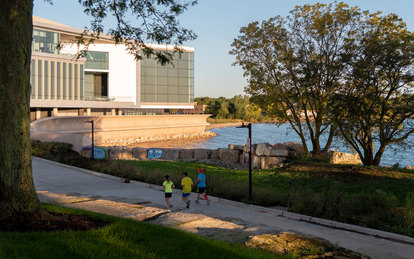Coastal Resilience Lessons from the Fresh Coast

The Great Lakes don’t always get their due as coastal environments. But with three of the largest fresh-water lakes in the world, their total amount of U.S. coastline is longer in miles than both the Pacific and Atlantic Oceans. Their coasts are also exposed to big waves, powerful storm forces, and recently the highest water levels in their recorded history.
While the Fresh Coast won’t experience the same continuous rise that our saltwater coasts will with climate-induced sea-level change, Great Lakes communities will still be grappling with the impacts of a changing climate. As warmer average temperatures lead to higher levels of precipitation, lake levels will more frequently reach or exceed their historic highs, with fluctuations leading to more damaging, erosive wave conditions.
SmithGroup has been helping to advance several innovative coastal resilience approaches in the Great Lakes region with direct relevance to saltwater coasts. The waterfront improvement project in Euclid, Ohio secured easements from 100 private property owners to stabilize a 0.75-mile stretch of eroding shoreline and bluffs – creating a publicly accessible waterfront trail in the process.

First-phase construction has brought Euclid’s resilient waterfront vision to life.
One of the key lessons from Euclid is that resilience at scale is as much or more about committed community partnerships and regulatory negotiations as it is about big design ideas. There is really no way to create effective systems of shoreline protection and wave mitigation on a parcel-by-parcel basis. Crossing public/private property lines is essential to finding a resilient solution, and Euclid provides a proven model for getting there. The approach has become a model for the Lake Erie region, and helped lead to the creation of Ohio’s first lakefront special improvement district to combat shoreline erosion.
Northwestern University was facing a smaller scale but equally pressing issue on their Lake Michigan campus. Rapidly increasing lake levels were threatening the Ryan Fieldhouse & Walter Athletics Center, a $280M facility that was set to start construction. The most effective and cost-effective solution was an innovative wave wall, built as a protective barrier in front of the facility using prefabricated, modular sections. It has proven to be an invaluable design retrofit for the university, as well as unique design feature embraced by the campus community.
Northwestern’s wave wall has won a series of awards over the past couple years. It is currently a finalist for a national Outstanding Civil Engineering Achievement (OCEA) award, along with eight other projects from across the U.S. The winner and two runners-up will be announced in October 2021. Regardless of the outcome, it is a huge honor to be in the running for an award that is typically won by large-scale infrastructure projects setting new standards for engineering innovation. The nomination recognizes the potential of even relatively small-scale adaptations in the built environment to provide significant benefits – especially when those adaptations are readily transferable to a wide range of situations and geographies.
As we continue to adapt our coasts and coastal communities to be more resilient to climate change impacts, we will be exploring other potential solutions. These solutions will include using an inclusive, neighborhood-based planning process when people need to be relocated to make way for flood-control measures, as happened in Milwaukee. They will also include using submerged reefs and living shoreline approaches to stabilize eroding beaches and natural areas – the approach we’ve helped model and develop for an endangered 1.5-mile stretch of Illinois Beach State Park.
Whatever approach is needed, the resilience lessons we’re learning in the Great Lakes represent important precedents that can applied to a wide range of coastal environments – both fresh and saltwater.